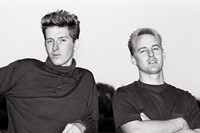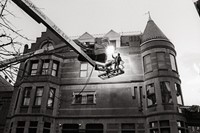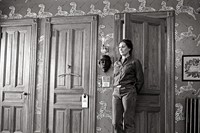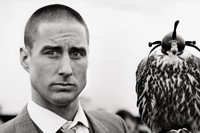A new book explores, in his own words and in witty, technical and technicolour detail, the work of Wes Anderson
Moonrise Kingdom, 2012
The most recently released of Anderson’s films is a story of true love between pre-teenagers, set against a backdrop of adult despondency. In Sam and Suzy, Anderson has two lovers who are wise and proactive beyond their years, and whose unprecedented elopement jolts their community off their cloud of despair and futility into action and therefore hope. This scene is extraordinary; a Nouvelle Vague homage, played out between two children, which exquisitely pinions the hilarity, embarrassment and fear of first love and a first kiss.
The Wes Anderson Collection is out now, published by Abrams.
Text by Tish Wrigley
Fantastic Mr Fox, 2009
The critics were unanimous – of course it was inevitable that a director with such a holistic vision would at some point move into animation. But in Fantastic Mr Fox, Anderson not only managed to create yet another near perfect example of his own craft, and one suitable for children, but one that was true to the spirit of Dahl. Truth was essential to the process – all the maquettes were created using real animal fur – but it is the incorporation of Roald Dahl’s distinctive hilarious horror with Anderson’s fables of families in crisis that make it a classic. As he says, “Dahl has [Mr Fox’s] tail shot off. We made it into a necktie. That might basically describe the collaboration.”
The Darjeeling Limited, 2007
In another stylistic flourish, Anderson’s fifth offering opened with a self-contained prologue film starring Jason Schwartzman and Natalie Portman. Set in the Parisian Hotel Chevalier, detailing the demise of a love affair that will be at the root of Schwartzman’s character’s despondency in the feature proper, it is characteristic of Anderson; a lush, gorgeous detail that was not strictly necessary but wonderful in its existence. And the use of everyone’s favourite song about Paris – Peter Sarstedt’s Where Do You Go To, My Lovely? – is a note of irreality that pushes it to the sublime.
The Life Aquatic, 2004
“Let me tell you about my boat.” And with a wave of Steve Zissou’s arm, we are taken inside the walls of the Belafonte, the interior revealed as if it was simply concealed behind the door of a doll’s house. This technically complicated and visually exhilarating vignette is an apt demonstration of the wonder and humour of Anderson’s films; an aura personified by his long-term collaborator Bill Murray. In the actor’s hangdog expression, there is a marvellous analogy for the spirit of an Anderson film; at once incredibly funny while riven with heartbreak, stalwartly borne.
The Royal Tenenbaums, 2001
The Royal Tenenbaums is a tale of a family that was broken by the father figure, and his belated efforts to attain redemption. It is funny and stuffed with musical delights and visual oddities – Richie’s everpresent tennis gear, the Dalmation mice that pop up in the corners – yet it is the heartbreak and the anguish that remains after the closing credits, emphasised by the humour with which they are juxtaposed. The story of Margot’s secret life is played out to the ostensibly jaunty crash of the Ramones, yet the montage detailing the run of relationships leading to her affair with Eli Cash, showing the haircut and coat that has stayed the same since childhood, speaks of a little girl who has never fully grown up or healed.
Rushmore, 1998
This story of an academically failing student who excels to an obsessive extent in extra-curricular activities was filmed on location at the school that the director himself attended. This montage, visually listing Max Fischer’s various activities in a yearbook style, is both brilliantly funny and a perfect representation of one of Anderson’s recurring cinematic tropes.
Bottle Rocket, 1996
From his first film, Anderson was using some of the cinematic tics that would become his trademarks, most noticeably the ‘god’s eye’ camera shot, and, of course, writing partner Owen Wilson.
To describe the films of Wes Anderson as unique is like placing the Disney films under the generic banner of cartoons. It’s obviously true – indeed, Anderson has created a cinematic language that is entirely his own – but this language has a vocabulary that is forged from a detailed patchwork of a million inspirations, perhaps more so than any other filmmaker working today. His is the bright, beautiful, playful world of a child, cracked through with the same fears, sadness and disappointment that dog the adult experience.
In a new book, The Wes Anderson Collection, film critic Matt Zoller Seitz sits down with the director to talk through each of his films in turn, from 1996’s Bottle Rocket all the way through to 2012’s Oscar nominated Moonrise Kingdom. This is a conversation that has been going on informally since 1993, when Zoller Seitz was the first professional film critic to review an Anderson film – the 12-minute monochrome short that would eventually be extended into Bottle Rocket. Now, in this exquisitely designed work, the ideas, inspirations and idiosyncrasies of Anderson’s aesthetic are spooled out alongside an incredible archive of stills, behind the scenes photography (much of it by Laura Wilson, Luke and Owen's mother), set illustrations, props and fascinating paraphernalia. He credits the films, directors and actors who have influenced him, goes geekily in-depth on the technological elements of his distinctive style and recalls definitive moments, such as meeting Owen Wilson at school, battling for Gene Hackman to play Royal Tenenbaum and the importance of Charlie Shultz’s Peanuts and Truffaut’s The 400 Blows. Just like an Anderson film itself, this is an extraordinarily immersive experience, littered with unexpected details, wit, sadness and stunning visuals, and it is one that will be returned to over and over again, each time providing something new, wonderful and profound.
To celebrate the new book, as well as the impending release of his new film The Grand Budapest Hotel, we too have taken each of Anderson’s seven films in turn and plucked out our highlights.
Follow AnOther Loves Wes on pinterest.





